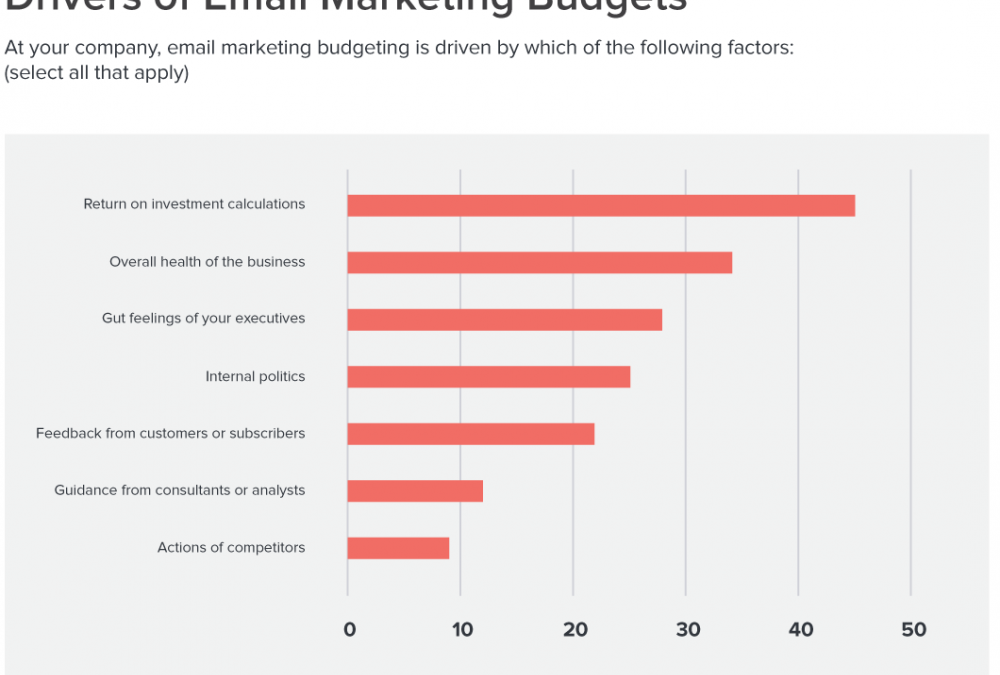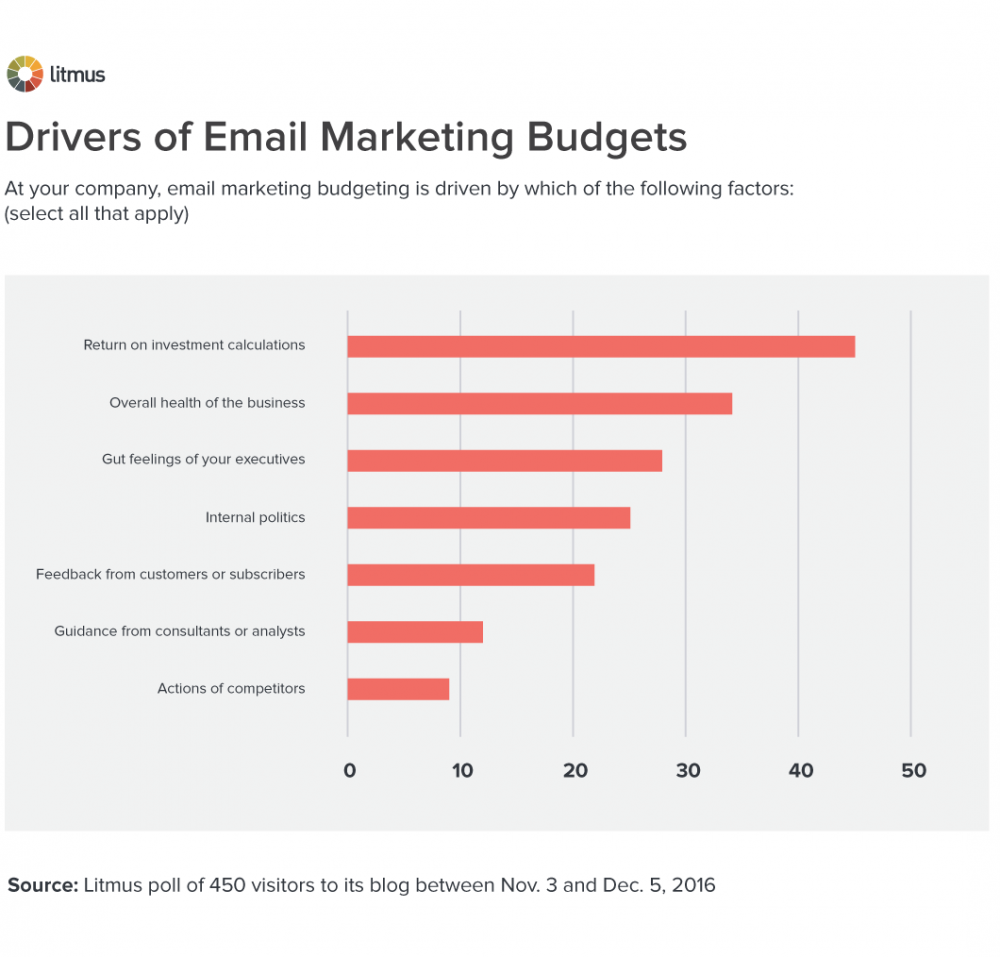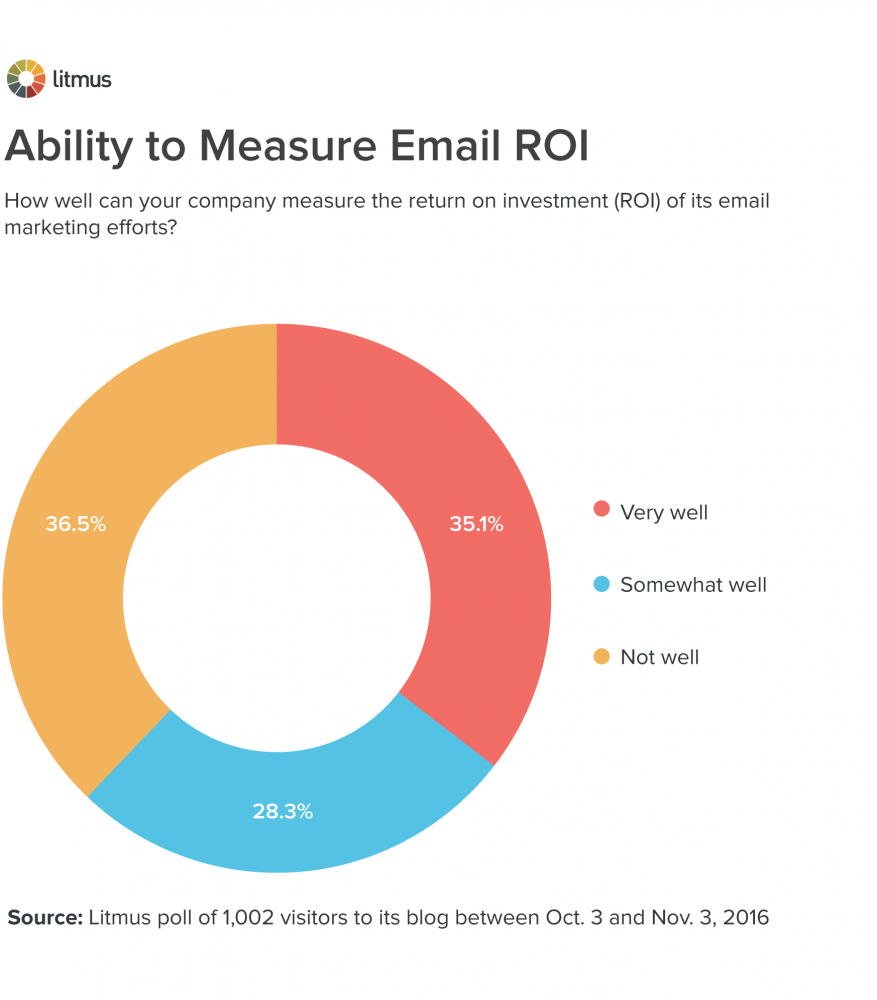As much as companies aspire to be data-driven in their budgeting decisions, the reality is that most business just aren’t there yet. The challenges are many—from systems that don’t talk to each other and a growing number of channels to disagreements about attribution models and internal politics. These challenges affect email marketing budgets, along with everything else.
When it comes to email marketing, companies use a range of factors to set budgets, including a strong reliance on gut feelings and internal politics.
More than one-third of marketers say two or more factors drive their companies’ email marketing budgets, an approach that likely more accurately accounts for the many competing factors that businesses wrestle with. But that leaves more than 65% saying their budgets are determined by just one factor. Among those relying on just one factor, 35.2% of marketers relied on return on investment (ROI) calculations, while the remaining 64.8% of marketers made budget decisions based solely on the overall health of the business (20.5%), the gut feelings of executives (16.0%), internal politics (15.0%), and other factors.
While ROI calculations came out on top in both of those groups, difficulty measuring the ROI holds back the shift to a more data-driven approach. Having many conversion channels, many marketing channels, and many systems can all complicate connecting the dots on ROI.
Being able to calculate your ROI is clearly a powerful way to justify email marketing budgets and to get buy-in for projects. However, if you work at one of the companies that’s among the 55.8% that doesn’t use ROI to determine email marketing budgets, how can you advocate better both for your overall budget and for incremental projects?
Arguments that Go Beyond ROI
For the best advice, Litmus reached out to experts at eMailMonday, Shaw + Scott, Adobe, Merkle, Barkley, Oracle, Email Optimization Shop, and RAPP.
Here are their tips for how to effectively argue for more email marketing resources…
1. Promote “Sexier” Adjacent Activities
Unfortunately, email marketing is often thought of as a mature channel. Given the tendency of companies to focus on shiny, new channels and techniques, that can make it challenging for email to compete in budget conversations. But you can also use that to your advantage, says Jordie van Rijn, an independent email and automation consultant at eMailMonday.
“Budget that goes into customer lifecycle marketing, marketing automation, or data science sounds much better and more innovative than email,” says van Rijn. “In practice, those involve a lot of email marketing activities.”
So promoting some hot trends can situate email marketing to your benefit.
2. Position Email More Broadly
In addition to piggybacking on enthusiasm for new channels and tactics, break email marketing out of its silo and position it as an important contributor to a range of critical functions.
“It’s hard for email to shake that cheap/easy/not sexy rap,” says Melissa Shaw, Co-CEO and Co-Founder, Shaw + Scott.
“Email marketers need to stress the importance of their role in a cohesive customer experience.” —Melissa Shaw of Shaw + Scott [Tweet this]
“For example, you can emphasize how email is a great test bed for optimizing marketing overall, honing in on effective segmentation strategies, creative treatments, messaging, offers, etc. You can also show how email interplays with other channels.”
Kristin Naragon, Director of Product Marketing at Adobe Campaign, agrees that email needs to de-silo. “Email marketers need to position their needs in the context of greater company goals and the customer experience,” she says. “A request will seem less tactical to an executive if the email marketer positions it as a way to accelerate larger company goals, rather than email marketing-specific goals.”
3. Leverage Transformative Initiatives
Big changes within marketing and the broader company are opportunities to reboot email’s position and stature, says Jose Cebrian, Vice President and General Manager of Email and Mobile Messaging at Merkle.
“When speaking about larger companies, the most effective argument I have seen is by couching the larger budget need in terms of a large-scale CRM marketing transformation,” he says. “Email, a component of the transformation, will drive a material change in how the company understands its customers and can communicate with them to drive a significant financial impact. As with all initiatives of this scale, it is a multi-year vision with alignment from senior executives across several disciplines.”
4. Leverage regulatory and brand compliance requirements
In the absence of a big, internally driven transformation anywhere on the horizon, look for other drivers—particularly ones that are required changes.
“There are four dimensions on which to rate an email project’s merit: regulatory compliance, brand compliance, return, and innovation,” says Cebrian. “The first two, regulatory and brand compliance, are required.”
These are great initiatives to hitch an email marketing project to, says Cebrian. “Regulatory-related projects are instituted because a law is being or will be broken. Brand compliance projects take place when there is a brand refresh at the company or a program such as automated emails has been running a long time and the content and branding are out of date. These tend not to provide an increase in return unless coupled with another initiative such as making the emails responsive, but for a brand-conscious company they must be completed.”
5. Collect Case Studies
While email marketing budgets may not be driven by the actions of competitors at many companies, there’s no doubt that case studies are a powerful persuasion tool.
“Case studies are one of the best ways to ‘prove’ that a program is worth investing in,” says Jessica Best, Director of Data-Driven Marketing at Barkley. “When I can tell clients of a similar industry company that tried something new and saw the results, it takes some of the fear of being on the bleeding edge out of the equation.”
6. Proof of Concept
Want to accomplish a big email marketing project? Your chances of success are substantially higher if you break the project up into several much smaller initiatives, because small, near-term wins give you momentum that you can take into the next phase of the project.
“I’ve seen email marketers be the most successful in securing budget by building confidence with a series of discrete and measurable wins,” says Shaw. “For example, you may aspire to invest in a multi-wave, cross-channel browse abandon effort. Can you build a business case by fencing off a couple of messages to a core segment in a single channel and use that to size the opportunity?”
“As an email marketer, you need credible data and a solid test design,” she adds. “Include a hold-out group if you want to be taken seriously by executives.”
7. Celebrate Your Successes
Don’t be quiet about your successes, and don’t hesitate to roll up a series of small successes to make a bigger statement.
“Showcase your wins and publicize them internally,” says Bradford Johnson, Senior Director, Strategic and Analytic Services at Oracle. “Email often has to do its own PR, so curate extremely brief spotlights of your ongoing wins and distribute these broadly.”
While this can seem like a distraction from your next email marketing task, try to view it as a core part of your job.
“It’s important to follow-up once the funding is received to show actual results,” says Jeanne Jennings, Principal of Email Optimization Shop. “Often, email marketers think they are too busy to go back and show the results of their efforts and the company’s investment. But doing this on a consistent basis makes getting a larger budget at the beginning of the new year a lot easier.”
Determine the best way within your company to regularly publicize your success, whether that’s via a monthly or quarterly email to stakeholders, a slide deck or Basecamp post that summarizes key results of your initiatives, or an in-person meeting where you can share results and learnings.
In addition to those, Cinnamon Brunmier-Keller, VP of Technology Services at RAPP, recommends video.
“We’ve found that video case studies work better than slide decks to create excitement and inspiration,” she says. “You can also say more in a 3- to 5-minute video—thanks to text animation, imagery, and voiceover—than you can in a 20-page slide presentation.”
8. Find Champions
As you celebrate your successes, use those occasions and others to cultivate champions for your future efforts.
“Email marketers need to build alliances within their organizations—with IT, finance, other marketing teams, etc.” —Kristin Naragon of Adobe [Tweet this]
“Budget requests for solutions that solve multiple teams’ problems are more likely to be better received by an executive,” she says, “especially when presented with a unified front.”
While cross-functional advocates are great and necessary, you also need to find champions within leadership.
“Email marketers have to successfully ‘manage up’ to executives with excellent analytical skills and storytelling skills,” says Shaw. “It’s an absolute imperative to be networking and building connections within your organization and not operating as a silo.”
Part of cultivating great executive champions is ensuring that they understand all the critical aspects of email marketing.
We’d like to help.
Company leadership doesn’t always fully understand the value of email marketing, and that creates unnecessary tension and underperformance. Litmus has identified a number of key email marketing topics and assembled 1-page executive briefs that marketers can share with management, including one on Why Companies Are Investing More in Email Marketing.
Download that and other 1-page briefs from our Email Marketing Leadership series for free.
 |
Email Marketing Leadership SeriesFree one-page, printer-friendly summaries on critical email marketing issues that you can share with the leadership at your company. |
The post 8 Ways to Get Executive Buy-In for Larger Email Marketing Budgets, Besides ROI appeared first on Litmus Software, Inc..



